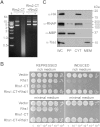Intraspecies Competition in Serratia marcescens Is Mediated by Type VI-Secreted Rhs Effectors and a Conserved Effector-Associated Accessory Protein
- PMID: 25939831
- PMCID: PMC4524185
- DOI: 10.1128/JB.00199-15
Intraspecies Competition in Serratia marcescens Is Mediated by Type VI-Secreted Rhs Effectors and a Conserved Effector-Associated Accessory Protein
Abstract
The type VI secretion system (T6SS) is widespread in Gram-negative bacteria and can deliver toxic effector proteins into eukaryotic cells or competitor bacteria. Antibacterial T6SSs are increasingly recognized as key mediators of interbacterial competition and may contribute to the outcome of many polymicrobial infections. Multiple antibacterial effectors can be delivered by these systems, with diverse activities against target cells and distinct modes of secretion. Polymorphic toxins containing Rhs repeat domains represent a recently identified and as-yet poorly characterized class of T6SS-dependent effectors. Previous work had revealed that the potent antibacterial T6SS of the opportunistic pathogen Serratia marcescens promotes intraspecies as well as interspecies competition (S. L. Murdoch, K. Trunk, G. English, M. J. Fritsch, E. Pourkarimi, and S. J. Coulthurst, J Bacteriol 193:6057-6069, 2011, http://dx.doi.org/10.1128/JB.05671-11). In this study, two new Rhs family antibacterial effectors delivered by this T6SS have been identified. One of these was shown to act as a DNase toxin, while the other contains a novel, cytoplasmic-acting toxin domain. Importantly, using S. marcescens, it has been demonstrated for the first time that Rhs proteins, rather than other T6SS-secreted effectors, can be the primary determinant of intraspecies competition. Furthermore, a new family of accessory proteins associated with T6SS effectors has been identified, exemplified by S. marcescens EagR1, which is specifically required for deployment of its associated Rhs effector. Together, these findings provide new insight into how bacteria can use the T6SS to deploy Rhs-family effectors and mediate different types of interbacterial interactions.
Importance: Infectious diseases caused by bacterial pathogens represent a continuing threat to health and economic prosperity. To counter this threat, we must understand how such organisms survive and prosper. The type VI secretion system is a weapon that many pathogens deploy to compete against rival bacterial cells by injecting multiple antibacterial toxins into them. The ability to compete is vital considering that bacteria generally live in mixed communities. We aimed to identify new toxins and understand their deployment and role in interbacterial competition. We describe two new type VI secretion system-delivered toxins of the Rhs class, demonstrate that this class can play a primary role in competition between closely related bacteria, and identify a new accessory factor needed for their delivery.
Copyright © 2015, Alcoforado Diniz and Coulthurst.
Figures





References
-
- Hood RD, Singh P, Hsu F, Guvener T, Carl MA, Trinidad RR, Silverman JM, Ohlson BB, Hicks KG, Plemel RL, Li M, Schwarz S, Wang WY, Merz AJ, Goodlett DR, Mougous JD. 2010. A type VI secretion system of Pseudomonas aeruginosa targets a toxin to bacteria. Cell Host Microbe 7:25–37. doi:10.1016/j.chom.2009.12.007. - DOI - PMC - PubMed
Publication types
MeSH terms
Substances
Associated data
- Actions
Grants and funding
LinkOut - more resources
Full Text Sources
Molecular Biology Databases

